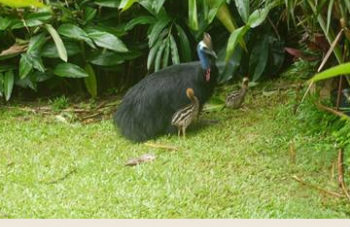
It’s that time of the year for some retrospection and in so doing I would like to congratulate the National Parks Rangers and all at DERM, including the pollies, for their response to the critical plight of the endangered populations of Cassowaries and Mahogany Gliders: these creatures lost their habitat and food supply from the damage done to the forest by cyclone ‘Yasi’. The work of the rangers would not have been possible without the dedicated support of volunteers who chopped over three ton of fruit per week and also helped in so many other ways to ensure the supplementary feeding programmes were successful.
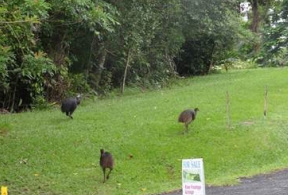
On November 10 2010 Bill Farmsworth sent me this photo (above3) of Dad 2 and his new chicks. The photo (right) was taken on Friday 30th December. The chicks are almost as large as Dad and still walking with him. It is very unusual for the chicks to stay with the Dad for more than 12 months.
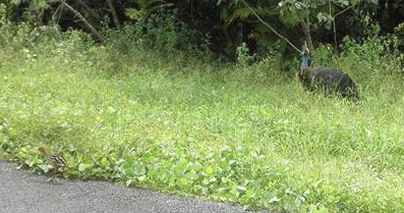
'Dad 1' lost one of his chicks during the night of cyclone Tasha that struck Innisfail on the 24 December 2010. Photo taken on the 27 December 2010. The surviving chick was named ‘Rosie’ by one of the National Park Rangers and she is doing fine and also still walking with Dad.
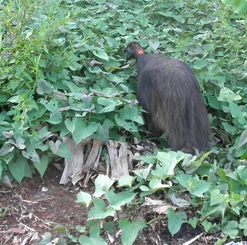
One week after the cyclone the subadult cassowary ‘Little Runt’ was in a very poor state when I found him collapsed in the sweet potato patch. I saw him again today for the first time in a couple of months and he is looking strong and fit.
Without the supplementary feeding programme many of these amazing birds would have died.
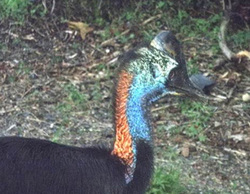
‘Dad 4’s’ two chicks ‘Don’ and ‘Q’ are doing fine but I have not seen the subadult ‘Captain Starlight’ for six weeks. One cassowary death was reported at Coquette Point this year. That’s the roll call of Coquette Point Cassowaries for 2011- one down and no new births.
My very best wishes to you for 2012,
Sincerely Yvonne C.
P.S My very dear friend, who lives deep in the rainforest at Mossman, ‘Bloodywertzie’ has corrected an error in last week’s news. Pink –tongued Skinks are born alive, not hatched from eggs as I indicated. Jim recalls seeing 26 young born to one skink at Mount Nebo. Jim also mentioned that there is also a much rarer light coloured unpatterned variety that is often mistaken for a new undescribed species.YC.

